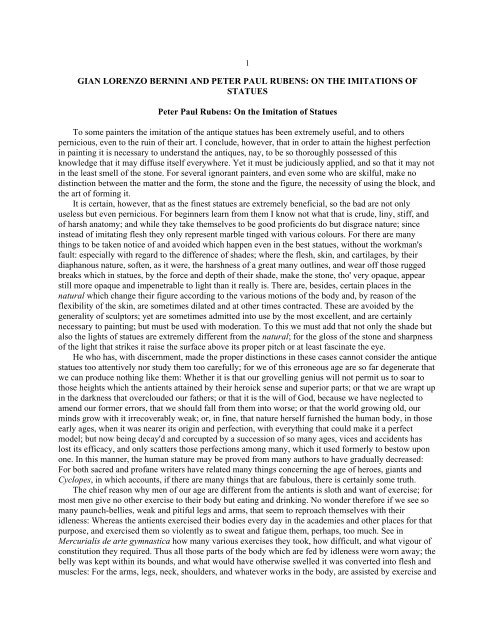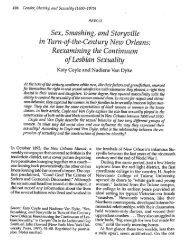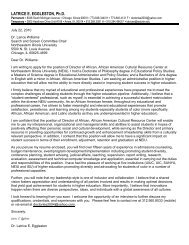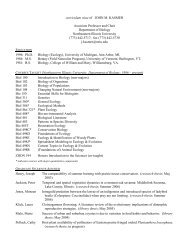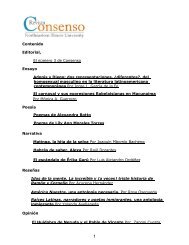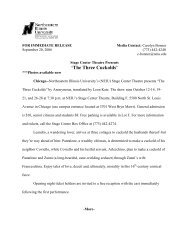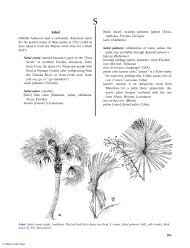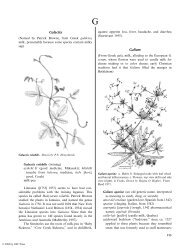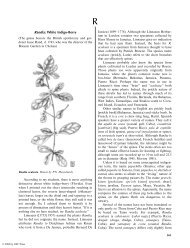GIAN LORENZO BERNINI AND PETER PAUL RUBENS: ON THE ...
GIAN LORENZO BERNINI AND PETER PAUL RUBENS: ON THE ...
GIAN LORENZO BERNINI AND PETER PAUL RUBENS: ON THE ...
You also want an ePaper? Increase the reach of your titles
YUMPU automatically turns print PDFs into web optimized ePapers that Google loves.
1<br />
<strong>GIAN</strong> <strong>LORENZO</strong> <strong>BERNINI</strong> <strong>AND</strong> <strong>PETER</strong> <strong>PAUL</strong> <strong>RUBENS</strong>: <strong>ON</strong> <strong>THE</strong> IMITATI<strong>ON</strong>S OF<br />
STATUES<br />
Peter Paul Rubens: On the Imitation of Statues<br />
To some painters the imitation of the antique statues has been extremely useful, and to others<br />
pernicious, even to the ruin of their art. I conclude, however, that in order to attain the highest perfection<br />
in painting it is necessary to understand the antiques, nay, to be so thoroughly possessed of this<br />
knowledge that it may diffuse itself everywhere. Yet it must be judiciously applied, and so that it may not<br />
in the least smell of the stone. For several ignorant painters, and even some who are skilful, make no<br />
distinction between the matter and the form, the stone and the figure, the necessity of using the block, and<br />
the art of forming it.<br />
It is certain, however, that as the finest statues are extremely beneficial, so the bad are not only<br />
useless but even pernicious. For beginners learn from them I know not what that is crude, liny, stiff, and<br />
of harsh anatomy; and while they take themselves to be good proficients do but disgrace nature; since<br />
instead of imitating flesh they only represent marble tinged with various colours. For there are many<br />
things to be taken notice of and avoided which happen even in the best statues, without the workman's<br />
fault: especially with regard to the difference of shades; where the flesh, skin, and cartilages, by their<br />
diaphanous nature, soften, as it were, the harshness of a great many outlines, and wear off those rugged<br />
breaks which in statues, by the force and depth of their shade, make the stone, tho' very opaque, appear<br />
still more opaque and impenetrable to light than it really is. There are, besides, certain places in the<br />
natural which change their figure according to the various motions of the body and, by reason of the<br />
flexibility of the skin, are sometimes dilated and at other times contracted. These are avoided by the<br />
generality of sculptors; yet are sometimes admitted into use by the most excellent, and are certainly<br />
necessary to painting; but must be used with moderation. To this we must add that not only the shade but<br />
also the lights of statues are extremely different from the natural; for the gloss of the stone and sharpness<br />
of the light that strikes it raise the surface above its proper pitch or at least fascinate the eye.<br />
He who has, with discernment, made the proper distinctions in these cases cannot consider the antique<br />
statues too attentively nor study them too carefully; for we of this erroneous age are so far degenerate that<br />
we can produce nothing like them: Whether it is that our grovelling genius will not permit us to soar to<br />
those heights which the antients attained by their heroick sense and superior parts; or that we are wrapt up<br />
in the darkness that overclouded our fathers; or that it is the will of God, because we have neglected to<br />
amend our former errors, that we should fall from them into worse; or that the world growing old, our<br />
minds grow with it irrecoverably weak; or, in fine, that nature herself furnished the human body, in those<br />
early ages, when it was nearer its origin and perfection, with everything that could make it a perfect<br />
model; but now being decay'd and corcupted by a succession of so many ages, vices and accidents has<br />
lost its efficacy, and only scatters those perfections among many, which it used formerly to bestow upon<br />
one. In this manner, the human stature may be proved from many authors to have gradually decreased:<br />
For both sacred and profane writers have related many things concerning the age of heroes, giants and<br />
Cyclopes, in which accounts, if there are many things that are fabulous, there is certainly some truth.<br />
The chief reason why men of our age are different from the antients is sloth and want of exercise; for<br />
most men give no other exercise to their body but eating and drinking. No wonder therefore if we see so<br />
many paunch-bellies, weak and pitiful legs and arms, that seem to reproach themselves with their<br />
idleness: Whereas the antients exercised their bodies every day in the academies and other places for that<br />
purpose, and exercised them so violently as to sweat and fatigue them, perhaps, too much. See in<br />
Mercurialis de arte gymnastica how many various exercises they took, how difficult, and what vigour of<br />
constitution they required. Thus all those parts of the body which are fed by idleness were worn away; the<br />
belly was kept within its bounds, and what would have otherwise swelled it was converted into flesh and<br />
muscles: For the arms, legs, neck, shoulders, and whatever works in the body, are assisted by exercise and
nourish'd with juice drawn into them by heat, and thus increase exceedingly both in strength and size; as<br />
appears from the backs of porters, the arms of prize fighters, the legs of dancers, and almost the whole<br />
body of watermen.<br />
2<br />
Gian Lorenzo Bernini in France—from the Diaries of Paul Freart de Chantelo<br />
On Portraiture in Sculpture<br />
Speaking of sculpture and the difficulty of achieving a successful result, and in particular of capturing<br />
a likeness in marble portraits, Bernini told me something remarkable that he has since repeated on several<br />
occasions: that is, that if someone were to whiten his hair, beard, eyebrows and, if possible, the pupils of<br />
his eyes and his lips, and then showed himself in that state, even those who saw him every day would<br />
have difficulty in recognizing him. And as proof of this he added: when a person falls into a faint the<br />
pallor that spreads over his face is alone sufficient to make him almost unrecognizable, so that we often<br />
say, ‘He no longer looks himself.’ For this reason it is very difficult to obtain a likeness in a marble<br />
portrait, which is all of one colour. He told me something else that is even more remarkable: that in a<br />
marble portrait it is sometimes necessary, in order to imitate nature well, to do what is not in nature.<br />
Though this may seem to be a paradox, he explained it in this way: in order to represent the bluish patch<br />
that some people have around the eyes, it is necessary to hollow out the marble at the place where this<br />
bluish colour is, so as to create the effect of the colour and by this artifice to make up, as it were, for the<br />
defect in the art of sculpture, which cannot give colour to things. Thus it is, he said, that nature and<br />
imitation are not the same thing.<br />
His Majesty told Bernini that he would not see him for three days but that in his absence he would be<br />
able to work on the hair of the bust portrait. Bernini replied that he would indeed work on it; he ventured<br />
to say to His Majesty that it was not an easy thing, because he wanted to give to this hair the lightness that<br />
it has in nature; that to do so it was necessary to combat the material, which is of a contrary nature, but<br />
that if His Majesty had seen his Daphne he would know that in that work he had found a satisfactory<br />
solution for the same kind of problem.<br />
M. de Crequi then spoke of the statue of Truth, which is in Bernini's place in Rome, as a work of<br />
perfect beauty. The Cavalier Bernini said that he made it in order to keep it in his house; that the figure of<br />
Time, who carries and reveals Truth, is not finished, and that it is his intention to represent him carrying<br />
her through the air and by the same means to show the effects of time, which finally destroys and<br />
consumes all things. He said that in his model he made columns, obelisks and mausolea, and that these<br />
things, which are shown as overthrown and destroyed by Time, are the very ones that support him in the<br />
air, for without them he couldn't be there, ‘although he has wings’, he said laughing. He added that at the<br />
Roman court there was currently a popular saying, ‘Truth is only to be found at the Cavalier Bernini's….’<br />
On Architecture<br />
The Nuncio remarked that when the Louvre was finished, buildings would be made in the same style.<br />
I replied that this could easily be believed, because the Louvre would then become the fashion. I said that<br />
all that was needed in France was one good example, and that even in Rome it was the remains of<br />
antiquity that served for both sculpture and architecture and continued to provide guidance and assistance<br />
in good practice through many beautiful and great examples. He would not agree with this, saying that the<br />
ancients had never done anything to equal St. Peter's. ‘If you mean mere grandeur of size and quantity of<br />
masonry,’ I replied, ‘I will not dispute this. But in grandeur of style St. Peter's is smaller than the Rotonda<br />
[the Pantheon] and inferior in nobility of workmanship, exactitude and diligence. In any event, monsieur,<br />
do you believe that there were no ancient temples in Greece and Italy that equalled St. Peter's in size and<br />
quantity of material?’ The Nuncio still maintained that there were none and then called the Cavalier<br />
Bernini to ask him if it were not true that St. Peter's was built in a more noble and more excellent style<br />
than the Pantheon. Bernini candidly replied no, that the most perfect forms are circles, squares, hexagons,
3<br />
octagons and the like, that the dome of St. Peter's is in truth beautiful and without parallel among antique<br />
works, but that there are a hundred faults in St. Peter's and none in the Pantheon. Michelangelo, he said,<br />
had not wanted a nave for St. Peter's, and there was a drawing of St. Peter's by Baldassare Peruzzi, which<br />
is to be seen in Serlio's book on architecture, which is much more beautiful than what was actually built.<br />
On the Study of Ancient Sculpture<br />
On September fifth, the Cavalier Bernini worked as usual and in the evening was at the Academy.<br />
MM. du Metz, Nocret and de Sève came to receive him at the street door as deputies of that body. The<br />
Cavalier went first to the place where they draw from the models, who, when they saw him, at once<br />
assumed the attitudes that had been given them. After staying there for some time he went on to the room<br />
where the academic lectures are held. He was offered the first place but did not wish to sit down... The<br />
Cavalier cast his eye over the paintings in the room, which happened not to be by the most talented artists,<br />
and looked also at some bas-reliefs by sculptors of the Academy. Later, while remaining standing in the<br />
middle of the room, surrounded by all the members of the Academy, he said that it was his opinion that<br />
they should have in the Academy casts of all the best ancient statues, bas-reliefs and busts for the<br />
instruction of young people, making them draw after these ancient models in order to instil in them at the<br />
outset that idea of beauty which would afterwards be useful to them for their whole life. It is dangerous,<br />
he said, to set them to draw from nature at the very beginning, because nature is almost always weak and<br />
paltry and because, if their imagination is filled only with that, they will never be able to produce<br />
anything beautiful and great which is not to be found in nature. Those who draw from nature must already<br />
have considerable skill in order to be able to recognize faults and to correct them, which young people<br />
who have no experience are incapable of doing… He went on to say that when he was still very young he<br />
often drew from the Antique, and when he found himself in difficulty with his first figure he turned to the<br />
Antinoüs as his oracle, adding that from day to day he then observed in that statue beauties that he had not<br />
previously seen and would never have seen, if he had not taken up the chisel to work in stone. For this<br />
reason he always advised his pupils, and everyone else, not to give themselves over to drawing and<br />
modelling so much that they could not also manage at the same time to work, whether in sculpture or in<br />
painting, by mixing production and imitation, the one with the other, and (so to speak) by combining<br />
action and contemplation, from which results a great and marvellous progress.


